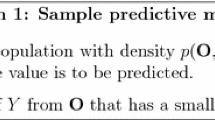Abstract
Determining and measuring cause-effect relationships is fundamental to most scientific studies of natural phenomena. The notion of causation is distinctly different from correlation which only looks at the association of trends or patterns in measurements. In this article, we review different notions of causality and focus especially on measuring causality from time-series data. Causality testing finds numerous applications in diverse disciplines such as neuroscience, econometrics, climatology, physics, and artificial intelligence.
Similar content being viewed by others
Suggested Reading
David R Cox, and Nanny Wermuth, Causality: A statistical view, International Statistical Review, Vol. 72, No. 3 pp. 285–305, 2004.
Irving John Good, A causal calculus (I), The British journal for the philosophy of science, Vol. 11, No. 44 pp. 305–318, 1961.
Irving John Good, A causal calculus (II), The British journal for the philosophy of science, Vol.12, pp.43–51, 1962.
P Suppes A probabilistic theory of causation, Amsterdam: North Holland.
Clive WJ. Granger, Investigating causal relations by econometric models and cross-spectral methods, Econometrica: Journal of the Econometric Society, PP.424-438, 1969.
Tore Schweder, Composable markov processes, Journal of applied probability, Vol. 7, No. 2 pp. 400–410, 1970.
Odd O Aalen, Dynamic modelling and causality, Scandinavian Actuarial Journal, pp.3-4, pp.177-190, 1987.
Ronald A Fisher, The arrangement of field experiments, Journal of the Ministry of Agriculture Great Britain, Vol.33, pp.503–513, 1926.
Ronald A Fisher, Design of experiments, Edinburgh: Oliver and Boyd. And subsequent editions, 1935.
Frank Yates, Design and Analysis of Factorial Experiments, Harpenden: Imperial Bureau of Soil Science, 1938.
Frank Yates, Bases logiques de la planification des experiences, Annals of the Institute of H. Poincaré, Vol.12, pp.97–112, 1951.
Donald B Rubin, Estimating causal effects of treatments in randomized and nonrandomized studies, Journal of educational Psychology, Vol.66, No.5, 688, 1974.
Sewall Wright, Correlation and causation, Journal of Agricultural Research, Vol.20, pp.557–585, 1921.
Sewall Wright, The method of path coefficients, Annals of Mathematical Statistics, Vol. 5, No. 3 pp. 161–215, 1934.
William G Cochran and S Paul Chambers, The planning of observational studies of human populations, Journal of the Royal Statistical Society, Series A (General) Vol.128, No.2, pp.234–266, 1965.
Judea Pearl, Causality: models, reasoning and inference, 29. Cambridge: MIT press, 2000.
Judea Pearl, and Dana Mackenzie, The book of why: the new science of cause and effect, Basic Books, 2018.
Aditi Kathpalia and Nithin Nagaraj, Data-based intervention approach for Complexity-Causality measure, Peer J Computer Science, Vol.5, p.e196, 2019.
Thomas Schreiber, Measuring information transfer, Physical review letters, Vol.85, No.2, p.461, 2000.
Norbert Wiener, The theory of prediction, Modern Mathematics for Engineers, Vol.1, pp.125–139, 1956.
George Sugihara, Robert May, Hao Ye, Chih-hao Hsieh, Ethan Deyle, Michael Fogarty and Stephan Munch, Detecting causality in complex ecosystems, science, Vol. 338, No. 6106 pp. 496–500, 2012.
Daniel Harnack, Erik Laminski, Maik Schünemann and Klaus Richard Pawelzik, Topological causality in dynamical systems, Physical review letters, Vol.119, No.9, p.098301, 2017.
Chris Chatfield, The analysis of time series: an introduction, Chapman and Hall/CRC, 2003.
C E Shannon, A mathematical theory of communication, The Bell system technical journal, Vol. 27, No. 3 pp. 379–123, 1948.
Alessandro Montalto, Luca Faes and Daniele Marinazzo, MuTE: a MATLAB toolbox to compare established and novel estimators of the multivariate transfer entropy, PloS one, Vol.9, No.10, p.e109462, 2014.
F Takens, Detecting strange attractors in turbulence, Dynamical Systems and Turbulence, Warwick 1980, pp.366-381, Springer, 1981.
Nithin Nagaraj, Karthi Balasubramanian and Sutirth Dey, A new complexity measure for time series analysis and classification, The European Physical Journal Special Topics, Vol.222, No.3–4, pp.847–860, 2013.
Karl J Friston, Lee Harrison and Will Penny, Dynamic causal modelling, Neuroimage, Vol. 19, No. 4 pp. 1273–1302, 2003.
Jerome Cornfield, William Haenszel, E Cuyler Hammond, Abraham M Lilienfeld, Michael B Shimkin and Ernst L Wynder, Smoking and lung cancer: recent evidence and a discussion of some questions, Journal of the National Cancer institute, Vol. 22, No. 1 pp. 173–203, 1959.
Acknowledgement
The authors gratefully acknowledge the financial support of ‘Cognitive Science Research Initiative’ (CSRI-DST) Grant No. DST/CSRI/2017/54(G) and Tata Trust provided for this research. Aditi Kathpalia is thankful to Manipal Academy of Higher Education for permitting this research as part of the PhD programme.
Author information
Authors and Affiliations
Corresponding authors
Additional information
Aditi Kathpalia is currently a PhD Scholar, Consciousness Studies Programme, National Institute of Advanced Studies, IISc Campus, Bengaluru. Her research interests include causality testing and its applications, chaos and information theory.
Nithin Nagaraj is currently Associate Professor, Consciousness Studies Programme, National Institute of Advanced Studies, IISc Campus, Bengaluru. His research areas include complexity theories of consciousness, chaos, information theory and causality testing.
Rights and permissions
About this article
Cite this article
Kathpalia, A., Nagaraj, N. Measuring Causality. Reson 26, 191–210 (2021). https://doi.org/10.1007/s12045-021-1119-y
Published:
Issue Date:
DOI: https://doi.org/10.1007/s12045-021-1119-y




